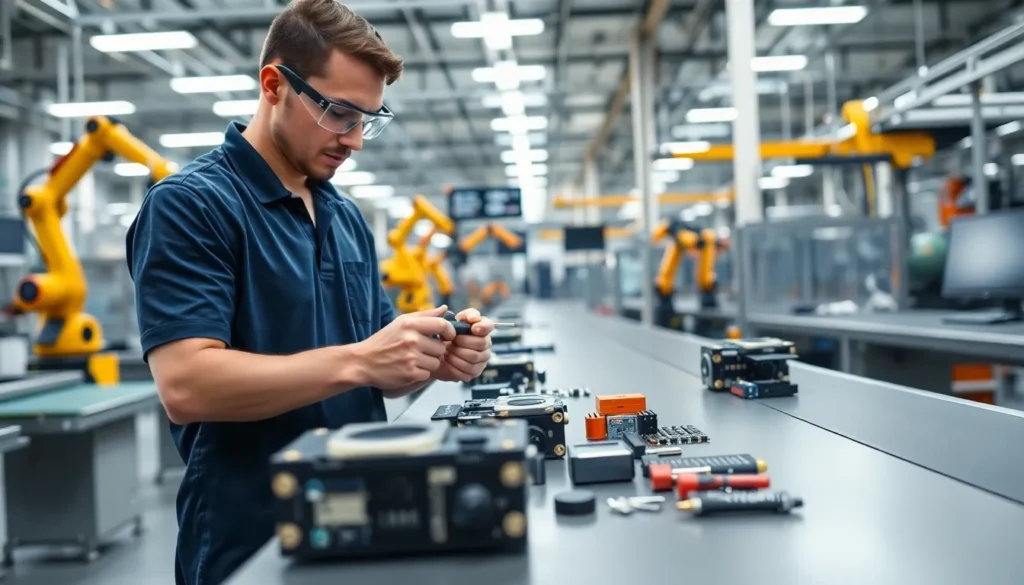Table of Contents
TogglePicture this: you’ve just received that thrilling package you’ve been eagerly waiting for. Inside, the potential for production magic lies in a pile of parts. But wait. Before you can marvel at your handiwork, you have to assemble it. Product assembly isn’t just about putting pieces together: it’s an art form that can bring both joy and frustration. This comprehensive guide will navigate the labyrinthine world of product assembly. Whether you’re a seasoned pro or a newbie with a penchant for puzzles, you’ll find insights that will save time and sanity. Let’s crack open the toolbox, no assembly required.
Understanding Product Assembly

Product assembly is the phase where raw materials, components, and parts go from a state of chaos to a cohesive product. This process can vary significantly based on the product type and industry. At its core, it involves the systematic combination of parts to create functional goods ready for market.
When one discusses product assembly, it’s crucial to recognize that it isn’t merely about physical assembly. It encompasses design considerations, workflow optimization, and even supply chain management. A focus on these elements ensures that products are not only assembled correctly but also efficiently, maintaining a high standard of quality throughout the process.
Types of Product Assembly
There are several types of product assembly that one may encounter, each with its own unique characteristics. Understanding these types can help streamline operations:
- Manual Assembly: This involves human labor to assemble products, utilizing tools and equipment for precision. Manual assembly is common for complex products that require attention to detail.
- Automated Assembly: Here, machines take a leading role in the assembly process. Automated assembly lines are efficient and consistent, often used in mass production scenarios.
- Semi-Automated Assembly: A hybrid approach combining both manual and automated processes, semi-automated assembly allows flexibility. Workers and machines collaborate, which often speeds up production while ensuring quality.
- Modular Assembly: This type is based on pre-made components or modules. It allows for easy interchangeability and is particularly useful for products that undergo frequent design changes.
Understanding these various assembly types aids in choosing the right technique based on product requirements and business goals.
The Product Assembly Process
The product assembly process can be broken down into several key stages:
- Planning: This phase involves strategizing the assembly workflow, identifying the necessary components, and determining workforce requirements.
- Procurement: At this stage, the required materials and parts are sourced from suppliers. Effectiveness here hinges on strong relationships with vendors to ensure timely delivery.
- Assembly: This is the hands-on phase where the actual product is put together. Whether it’s manual or automated, attention to detail is paramount.
- Testing: Once assembled, products undergo rigorous testing to ensure they meet quality standards. This can involve functional tests, stress tests, and compliance checks.
- Packaging: Finally, products are packaged for shipping. Packaging protects the product and provides branding opportunities.
Each of these stages is crucial for successful product assembly, and inefficiencies at any point can lead to delays or quality issues.
Tools and Equipment for Assembly
A variety of tools and equipment play a vital role in effective product assembly. Some of the most commonly used include:
- Hand Tools: Basic yet essential, hand tools like screwdrivers, pliers, and wrenches help with manual assembly tasks.
- Power Tools: Equipment such as drills and riveters increase efficiency, especially in automated settings.
- Conveyor Systems: These streamline the movement of components during the assembly process, minimizing downtime.
- Robotic Arms: In high-volume production environments, robotic arms can perform repetitive tasks with speed and accuracy, reducing labor costs.
- Quality Control Instruments: Devices such as calipers and gauges ensure that assembled products maintain quality and consistency.
Investing in the right tools and equipment not only enhances efficiency but also significantly improves the quality of the final product.
Quality Control in Product Assembly
Quality control is a non-negotiable aspect of product assembly. Establishing rigorous quality standards prevents defects and enhances customer satisfaction. Here are typical measures employed:
- Inspections: Regular inspections throughout the assembly process help catch defects early, preventing costly rework later.
- Statistical Process Control: This method analyzes production data in real time to identify trends and variances, allowing for proactive adjustments.
- Final Testing: After assembly, performing detailed tests ensures the product meets industry regulations and customer expectations.
- Employee Training: Continuous training of assembly line workers in quality standards fosters a culture of excellence.
A robust quality control system is not only about meeting compliance: it’s about instilling confidence in consumers and minimizing returns due to product defects.
Common Challenges in Product Assembly
While product assembly can be rewarding, it also presents several challenges:
- Supply Chain Issues: Delayed shipments of parts can derail assembly timelines. Strong supply chain partnerships can mitigate this risk.
- Labor Shortages: The skilled labor market is tighter than ever, making it difficult to find qualified workers to handle intricate assembly tasks.
- Complex Designs: As products evolve, assembly becomes more complicated. Keeping assembly instructions clear and straightforward is essential.
- Equipment Malfunction: Unforeseen breakdowns can halt production. Regular maintenance can help ensure that all equipment runs smoothly.
Addressing these challenges requires constant vigilance and a willingness to adapt operations as necessary.
Future Trends in Product Assembly
Looking forward, several trends are shaping the landscape of product assembly:
- Increased Automation: As technology advances, automated systems will become even more integral to assembly lines, allowing for quicker adjustments and improved efficiency.
- Sustainable Practices: A growing focus on sustainability will drive companies to seek eco-friendly materials and processes throughout the assembly chain.
- Smart Manufacturing: The rise of IoT (Internet of Things) technologies enables real-time monitoring and adjustments, which enhances overall performance.
- Collaborative Robots: Cobots working alongside human workers will help more flexible assembly processes, further enhancing productivity without sacrificing quality.
Staying ahead of these trends is crucial for businesses looking to maintain a competitive edge in the assembly landscape.







